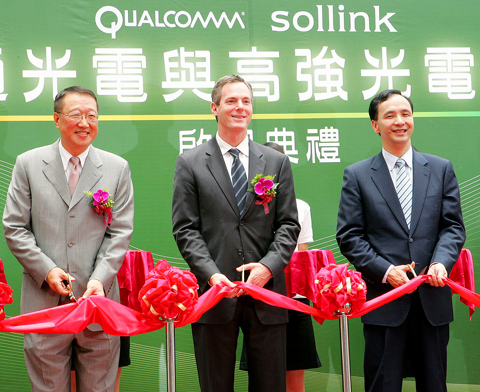Sollink Inc (高強光電), a display manufacturing subsidiary of electronic component maker Cheng Uei Precision Industry Co (Foxlink, 正崴), said yesterday it would soon make its first shipment of next-generation handset displays using Qualcomm Inc technologies.
Foxlink invested NT$500 million (US$15.18 million) to set up Sollink last year.
It plans to invest NT$30 billion on building plants, with the first being a 4.5-generation (4.5G) plant, the Science Park Administration in Hsinchu said.

PHOTO: MAURICE TSAI, BLOOMBERG
In March, Sollink produced the first display using the so-called mirasol technology from Qualcomm MEMS, a fully owned display subsidiary of US handset chipmaker Qualcomm.
The display’s nature-based design results in low energy consumption and high reflectivity, offering consumers extended battery life and superior outdoor visibility, Sollink said.
A mirasol display consumes 40 percent less energy than a comparable liquid-crystal display, it said.
The potential market for such energy-efficient displays could be as high as US$11 billion a year, Qualcomm chief executive Paul Jacobs has said.
Mirasol and similar displays would be suitable for mobile devices including handsets, portable navigation devices and portable multimedia players as well as electronic readers, he said.
“We just started a test run of the plant. We don’t expect the plant will have significant contribution [to our revenues] until we reach economic scale by building our second, or third plants,” Foxlink and Sollink chairman Gou Tai-chiang (郭台強) said.
Foxlink wants to form a long-term partnership with Qualcomm and Sollink was the first step, Gou said.
Foxlink wants to become an electronic component supplier to Qualcomm in several areas, including communications products and smartbooks, he said.
Chinese electronics maker Hisense Group (海信集團) and local mobile phone makers Cal-Comp Electronics (Thailand) Pub Co Ltd (泰金寶) — a subsidiary of local electronics group Kinpo Group (金仁寶集團) — and Inventec Corp (英業達) are planning to use mirasol displays for their mobile devices, Sollink said.
“We expect the new mirasol displays to be shipped with Foxlink’s products in the near term,” James Lee (李政), a Foxlink board member, told a press briefing yesterday. “That will be a 1.43-inch display for ultra-slim mobile phones with thickness of 7mm.”
Shares of Foxlink declined 4.26 percent to NT$48.4 yesterday, underperforming the benchmark TAIEX, which fell 3.45 percent.

Intel Corp chief executive officer Lip-Bu Tan (陳立武) is expected to meet with Taiwanese suppliers next month in conjunction with the opening of the Computex Taipei trade show, supply chain sources said on Monday. The visit, the first for Tan to Taiwan since assuming his new post last month, would be aimed at enhancing Intel’s ties with suppliers in Taiwan as he attempts to help turn around the struggling US chipmaker, the sources said. Tan is to hold a banquet to celebrate Intel’s 40-year presence in Taiwan before Computex opens on May 20 and invite dozens of Taiwanese suppliers to exchange views

Application-specific integrated circuit designer Faraday Technology Corp (智原) yesterday said that although revenue this quarter would decline 30 percent from last quarter, it retained its full-year forecast of revenue growth of 100 percent. The company attributed the quarterly drop to a slowdown in customers’ production of chips using Faraday’s advanced packaging technology. The company is still confident about its revenue growth this year, given its strong “design-win” — or the projects it won to help customers design their chips, Faraday president Steve Wang (王國雍) told an online earnings conference. “The design-win this year is better than we expected. We believe we will win

Chizuko Kimura has become the first female sushi chef in the world to win a Michelin star, fulfilling a promise she made to her dying husband to continue his legacy. The 54-year-old Japanese chef regained the Michelin star her late husband, Shunei Kimura, won three years ago for their Sushi Shunei restaurant in Paris. For Shunei Kimura, the star was a dream come true. However, the joy was short-lived. He died from cancer just three months later in June 2022. He was 65. The following year, the restaurant in the heart of Montmartre lost its star rating. Chizuko Kimura insisted that the new star is still down

While China’s leaders use their economic and political might to fight US President Donald Trump’s trade war “to the end,” its army of social media soldiers are embarking on a more humorous campaign online. Trump’s tariff blitz has seen Washington and Beijing impose eye-watering duties on imports from the other, fanning a standoff between the economic superpowers that has sparked global recession fears and sent markets into a tailspin. Trump says his policy is a response to years of being “ripped off” by other countries and aims to bring manufacturing to the US, forcing companies to employ US workers. However, China’s online warriors